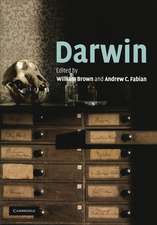Evolution and Impact of Transposable Elements: Contemporary Issues in Genetics and Evolution, cartea 6
Editat de Pierre Capyen Limba Engleză Hardback – 31 ian 1998
| Toate formatele și edițiile | Preț | Express |
|---|---|---|
| Paperback (1) | 1229.10 lei 6-8 săpt. | |
| SPRINGER NETHERLANDS – 12 oct 2012 | 1229.10 lei 6-8 săpt. | |
| Hardback (1) | 1072.17 lei 38-44 zile | |
| SPRINGER NETHERLANDS – 31 ian 1998 | 1072.17 lei 38-44 zile |
Preț: 1072.17 lei
Preț vechi: 1410.75 lei
-24% Nou
Puncte Express: 1608
Preț estimativ în valută:
205.16€ • 214.75$ • 170.76£
205.16€ • 214.75$ • 170.76£
Carte tipărită la comandă
Livrare economică 28 martie-03 aprilie
Preluare comenzi: 021 569.72.76
Specificații
ISBN-13: 9780792346906
ISBN-10: 0792346904
Pagini: 309
Ilustrații: VII, 309 p.
Dimensiuni: 210 x 279 x 25 mm
Ediția:1997
Editura: SPRINGER NETHERLANDS
Colecția Springer
Seria Contemporary Issues in Genetics and Evolution
Locul publicării:Dordrecht, Netherlands
ISBN-10: 0792346904
Pagini: 309
Ilustrații: VII, 309 p.
Dimensiuni: 210 x 279 x 25 mm
Ediția:1997
Editura: SPRINGER NETHERLANDS
Colecția Springer
Seria Contemporary Issues in Genetics and Evolution
Locul publicării:Dordrecht, Netherlands
Public țintă
ResearchCuprins
I. Structure of transposable element.- LTR retrotransposons and the evolution of eukaryotic enhancers.- What makes Grande1 retrotransposon different?.- About the origin of retroviruses and the co-evolution of the gypsy retrovirus with the Drosophila flamenco host gene.- Structural analysis of Drosophila subobscura gypsy elements (gypsyDs).- Evolution of R1 and R2 in the rDNA units of the genus Drosophila.- Do the integrases of LTR-retrotransposons and class II element transposases have a common ancestor?.- II. Transposable elements and heterochromatin.- Evolutionary links between telomeres and transposable elements.- Constitutive heterochromatin and transposable elements in Drosophila melanogaster.- P element regulation and X-chromosome subtelomeric heterochromatin in Drosophila melanogaster.- III. Transposable elements and host phylogenies.- Quasispecies in retrotransposons: a role for sequence variability in Tntl evolution.- Genetic and molecular investigations on the endogenous mobile elements of non-drosophilid fruitflies.- Genomic distribution of the retrovirus-like element ZAM in Drosophila.- CM-gag, a transposable-like element reiterated in the genome of Culex pipiens mosquitoes contains only a gag gene.- IV. Dynamics and regulation of transposable elements.- Evidence for a host role in regulating the activity of transposable elements in Drosophila melanogaster: the case of the persistent instability of Baril elements in Charolles stock.- Plant S1 SINEs as model to study retroposition.- Maintenance of transposable element copy number in natural populations of Drosophila melanogaster and D. simulans.- Accumulation of transposable elements in laboratory ines of Drosophila melanogaster.- Regulation of the transposable element mariner.- The evolution of Ty1-copia group retrotransposons in eukaryote genomes.- The chromosomal distributions of Ty1-copia group retrotransposable elements in higher plants and their implications for genome evolution.- The Ty1-copia group of retrotransposons in plants: genomic organisation, evolution, and use as molecular markers.- BARE-1 insertion site preferences and evolutionary conservation of RNA and cDNA processing sites.- BARE-1D, a representative of a family of BARE-like elements of the barley genome.- The expression of the tobacco Tnt1 retrotransposon is linked to plant defense responses.- Fungal transposable elements and genome evolution.- Molecular domestication of mobile elements.- Genomic signatures: tracing the origin of retroelements at the nucleotide level C - Models of transposable elements dynamics.- Population genetics models of transposable elements.- A simulation of the P element horizontal transfer in Drosophila.
























